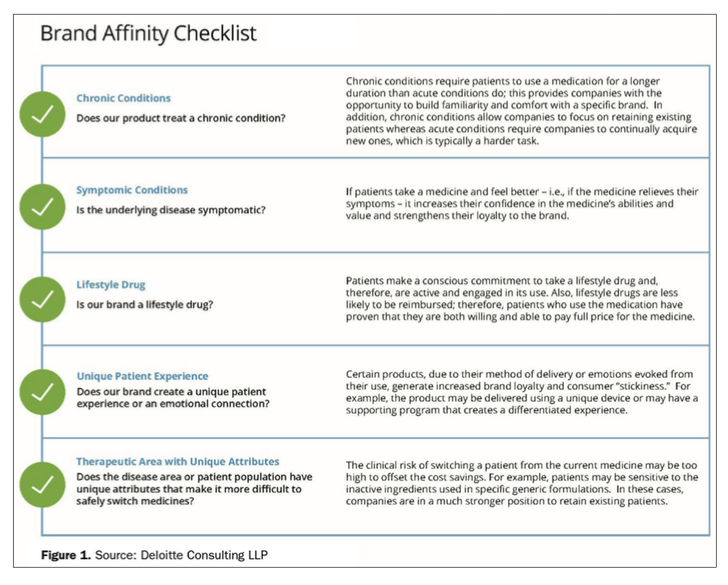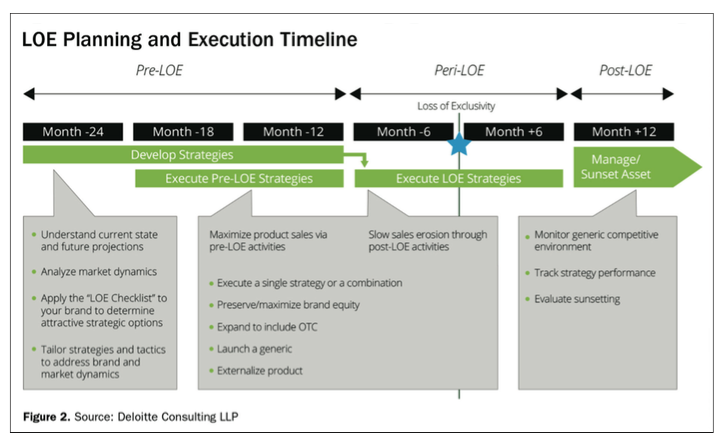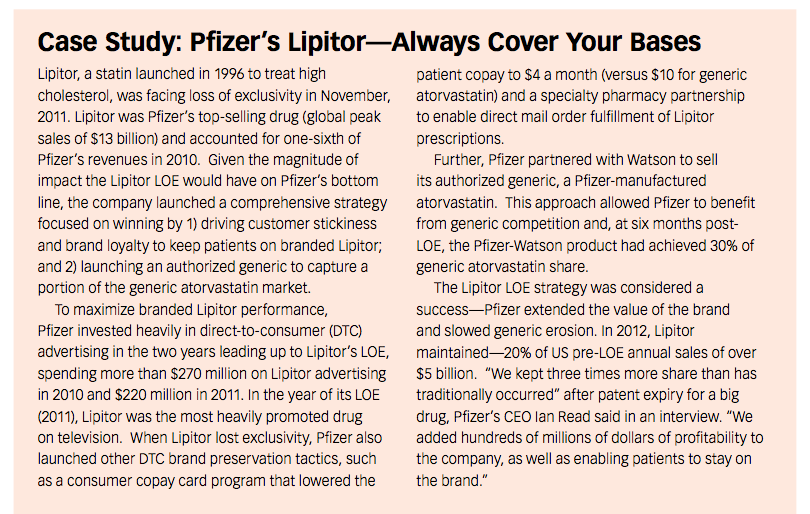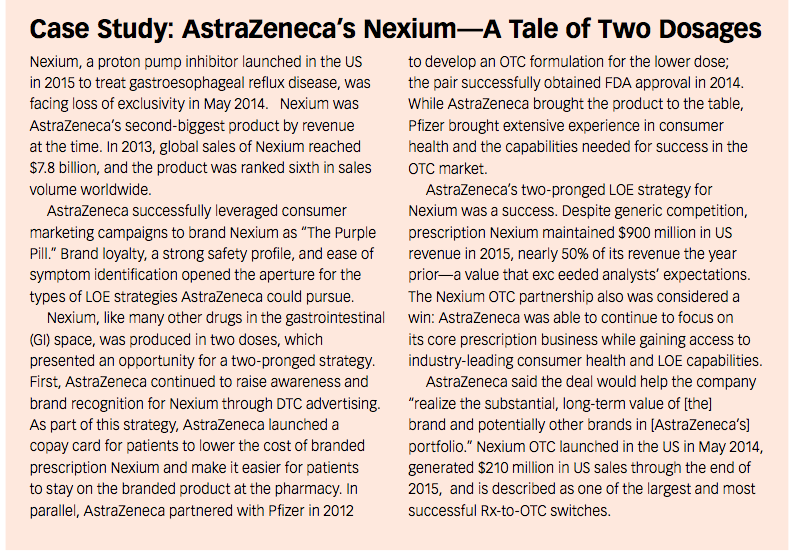Loss of Exclusivity: Strategies to Maximize Product Value
Pharmaceutical Executive
Loss of exclusivity (LOE) doesn’t have to be the death knell for branded drug revenue streams. The key approaches to preserving meaningful value well into the post-patent-loss future are outlined.
Between 2014 and 2020, a combined total of $259 billion in worldwide pharmaceutical sales are at risk from patent expiration, with $70 billion at risk in 2016 and 2017 alone. Scary numbers, especially when common wisdom holds that, practically speaking, loss of exclusivity (LOE) could mean the end of a product’s value…and revenue stream.
LOE almost always causes a precipitous decline in sales for small molecule drugs-on average, brand unit share dips to 16% by the time generics have been on the market for one year. However, it’s not the end of the line- focused efforts can preserve meaningful value for the brand. LOE is a natural milestone in a product’s lifecycle which-similar to market launch-should be strategically planned for and managed. Even when a pharmaceutical company exhausts all options to extend a product’s patent life (reformulations, new indications, etc.), revenue opportunities remain. A key is early action: a company should consider starting the LOE planning process two years before the anticipated patent expiry date.
Three value-extending strategies
Three LOE strategies have shown demonstrable success in extending a small molecule drug’s value. These revenue-generating strategies can be executed as standalone options or in combination, as illustrated by Pfizer and AstraZeneca’s successful LOE strategies for their branded products Lipitor and Nexium, respectively (see sidebars at end of article).
1. Preserve brand equity and patient loyalty. To slow brand erosion and continue sales momentum, a company may decide to shift its focus from core marketing and sales activities designed to maximize sales prior to LOE to a new set of activities intended to drive patient acquisition and retention to maximize sales through the LOE period-even if that means sacrificing some revenue in the pre-LOE window. This strategy taps into established brand equity and patient loyalty and drives increased awareness of the branded product’s ongoing availability. For example, three to six months before LOE, a company could start to lessen reliance on reimbursement from health plans by transitioning patients to a copay card to drive affordability and reduce patient out-of-pocket (OOP) expenses to levels equivalent to those with generics. This may help maintain sales volume and reduce the velocity of profit erosion. A company also might drive patient retention by creating enrollment programs (e.g., mail-order, copay cards) that collect patient information and help facilitate targeted interactions (e.g., refill notices) and remind patients that the branded product is still available even after generics have launched.
These and other similar tactics may help drive larger margins by keeping patients on branded therapy in a cost-effective manner. Overall, our experience has shown that effective deployment of tactics like these can drive anywhere from a 2x to a 20x return on investment, depending on the approach taken.
When evaluating a strategy to preserve brand equity, a branded drug company should be mindful that pricing pressures increase as the number of generic competitors rises-generic-to-brand price ratios tend to remain above 50% when only one or two generics are available but dip below 25% with five or more generics. This dynamic may impact its choices around marketing investment levels and tactics. Specifically, if there are five or more generic competitors in the market, it may not be attractive to pursue this strategy because a branded company’s costs may be too high and the revenue they can preserve too low to be viable.
Also, this isn’t a one-and-done decision-the number of generic competitors is likely to increase or decrease over time so companies should continue to reevaluate their decision to continue to invest in the brand. If the market becomes too saturated with generics and the price gets too low, companies may need to “turn off” this strategy, choose another option or, as explained later, “sunset” the brand. Alternatively, if generic competitors drop out of the market, it may be worthwhile to increase investments over time.
2. Create an over-the-counter (OTC) formulation. Some drug manufacturers may choose to create an OTC version of their branded product to maintain and/or grow volume post-LOE. An OTC formulation strategy may help a company to decelerate value erosion post-LOE, maintain current customers and acquire new ones, and protect the branded product’s long-term revenue stream. An OTC strategy is also attractive because it allows a company to gain access to a broader base of potential patients and removes reimbursement hurdles from the equation.
Companies that pursue an OTC strategy often need to invest more in the product for additional trials, regulatory approval and, potentially, reformulation. These important steps can prove to be challenging as regulators consider patient safety when using the product without a physician’s supervision. Even after overcoming these challenges, a company may have to invest in new retail sales channels and marketing programs to gain share. Fortunately, it may be able to do this cost-effectively via a partnership with others who already have developed the channels.
3. Launch a generic. A branded drug company may be able to profit directly from patients who migrate to a generic alternative by offering a generic. While this may seem counterintuitive, the company can manufacture a generic version of the branded drug or partner with another party to do so. Variations of this strategy include:
- Branded generic: Leverage existing product supplies and approvals to create a generic product to be sold by the branded company.
- Authorized generic: Use existing product manufacturing capacity to provide a private-label company with the same product.
- Licensed generic: Contract with a generic competitor to produce a generic version of the branded drug; this allows the competitor to enter the market earlier than it would be allowed to otherwise.
This strategy can allow the branded company to retain a higher portion of product value with relatively low implementation costs. However, companies need to thoroughly understand the anticipated generic landscape before implementing the strategy. The launch of a new generic must be carefully timed so that the product isn’t the first to market (and, therefore, the first to introduce price competition for the brand) but is launched early enough to capture a significant share of the generic market.
One of the best times for a branded company to launch a generic is when a generic company has effectively challenged the brand’s patent and is granted 180 days of market exclusivity. In situations like these, the generic launched by the originator company has been able to capture 30-50% of generic drug sales. This strategy is more attractive when the total number of generic entrants is expected to be relatively low (less then five) -once that number increases, the new generic drug’s price and market share may be too low to justify the approach.
As a side note, a company that chooses to implement one of the three revenue-generating LOE strategies may move forward using in-house resources or by collaborating with an external partner. Options could include co-promotions with royalty streams, out-licensing, or contracting with a company that has experience managing LOE events to maximize profit post-LOE. Externalization can benefit companies by helping them maintain focus on their core business while allowing them to access best-in-breed capabilities from across the industry.
The last resort: Sunset the brand
If the highlighted three LOE strategies aren’t a match for your product’s attributes and company’s broader capabilities and business objectives, there is a fourth option-sunset the brand. In this approach, companies continue to manufacture the product but suspend all marketing and sales investments and adjust inventory levels to account for the decline in demand.
To effectively sunset a product, the company should review all of the ongoing cost drivers and determine the best path forward to minimize the expenditures required to maintain a presence in the market. For example, it may be possible to reduce the number of SKUs and, in turn, reduce manufacturing and inventory costs. It is also important to understand that products approach the point of sunset at different rates. Product and market dynamics may help determine the right time to sunset a brand-for example, a higher number of generic competitors may accelerate the process.
Consult the brand affinity checklist
One overarching criterion that can help to determine the optimal path(s) to effective LOE management is brand affinity, the level of customer engagement and comfort with the brand. Applying the answers from the brand affinity checklist (see Figure 1) can help to guide strategic decision-making and increase the effectiveness of LOE planning.
Figure 1. Click to enlarge

If brand affinity is high, then both preserving and maximizing the brand and switching to OTC may be attractive LOE options. To evaluate whether switching to OTC is viable, a company should answer this key question: Would the current Rx product-or a modification thereof-satisfy the FDA’s strict OTC approval criteria? Considerations include the ease of symptom identification, product safety profile, potential for misuse or abuse, regimen complexity, and patients’ ability to self-manage the disease. If the answer is yes, a two-pronged Rx and OTC LOE strategy may be appropriate. If the answer is no, it may be better to double-down on the Rx strategy.
A company also should consider the intensity of market competition before moving forward with either of these options. For example, it may be difficult for a company to benefit from pursuing an OTC strategy if it is unable to lock in a period of exclusivity to drive OTC volume. Further, the effectiveness of differentiation and loyalty tactics is dampened when the market offers more treatment options.
If brand affinity is low, then the most likely options are to launch a generic or sunset the brand. Launching a generic is the more resource-intensive of these two approaches and its success is highly dependent on speed to market because the company will have greater opportunity to capture market share by locking in contracts with distributors and wholesalers. Therefore, the strategy should only be deployed if a company has the internal capabilities or the third-party relationships to get to market quickly and capture wholesaler/pharmacy contracts to drive volume.
Finally, when deciding whether to execute an LOE strategy in-house or with an external partner, companies need to consider myriad variables, including organizational capabilities, risk tolerance, portfolio (whether similar products allow for an optimization play across products), and the commercial attractiveness of a longer-term play in generics.
Two years and counting down
No matter which LOE strategy a company chooses to pursue, planning should commence two years prior to the anticipated LOE date. An early start is essential to allow the organization time to develop and deploy its LOE strategy before the LOE date. Generally speaking, if a company waits until after LOE to deploy its LOE
Figure 2. Click to enlarge

strategy it is too late and the impact of any LOE efforts will be greatly diminished. As illustrated in Figure 2, a typical planning and execution timeline is segmented into pre-LOE, peri-LOE, and post-LOE periods. Among important considerations:
- The peri-LOE period, six months before to six months after LOE, is the primary time to launch the selected LOE strategy in the market.
- Efforts to build and implement a preserve/maximize brand equity strategy should begin one-to-two years before LOE to build programs and launch the offering in the final six months of exclusivity.
- Companies choosing the OTC option will need to begin work earlier than those producing an authorized generic because OTC product approval has a longer lead time than other, more marketing-centric, approaches.
- Externalizing a product typically has a one-to-two-year time horizon.
Manage the milestone, generate value
Product LOE isn’t something that happens to a pharmaceutical company, it is a milestone event with significant forward visibility. A company can continue to generate value and revenue from its LOE brands but proactive management is required to do so. Strategic planning should begin two years before LOE, but, for companies already within that two-year window, all is not lost-although the urgency to act now and accelerate planning efforts is definitely greater.
Finally, LOE strategy can and should evolve over time to address changing business priorities and market conditions; companies should continuously monitor, evaluate, and adapt their strategy as needed during not only the pre- and peri-LOE periods but also throughout the post-LOE period-you never know when something may change in the generic landscape.
Case study: Lipitor (click to enlarge)

Casey study: Nexium

Faith Glazier (fglazier@deloitte.com) and Tom Fezza (tfezza@deloitte.com) are Principals; Jodi Reynolds (joreynolds@deloitte.com) is Senior Manager; all with Deloitte Consulting LLP

The Misinformation Maze: Navigating Public Health in the Digital Age
March 11th 2025Jennifer Butler, chief commercial officer of Pleio, discusses misinformation's threat to public health, where patients are turning for trustworthy health information, the industry's pivot to peer-to-patient strategies to educate patients, and more.
Navigating Distrust: Pharma in the Age of Social Media
February 18th 2025Ian Baer, Founder and CEO of Sooth, discusses how the growing distrust in social media will impact industry marketing strategies and the relationships between pharmaceutical companies and the patients they aim to serve. He also explains dark social, how to combat misinformation, closing the trust gap, and more.